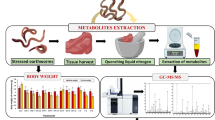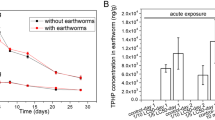Abstract
One of the promises of environmental metabolomics, together with other ecotoxicogenomic approaches, is that it can give information on toxic compound mechanism of action (MOA), by providing a specific response profile or fingerprint. This could then be used either for screening in the context of chemical risk assessment, or potentially in contaminated site assessment for determining what compound classes were causing a toxic effect. However for either of these two ends to be achievable, it is first necessary to know if different compounds do indeed elicit specific and distinct metabolic profile responses. Such a comparative study has not yet been carried out for the earthworm Lumbricus rubellus. We exposed L. rubellus to sub-lethal concentrations of three very different toxicants (CdCl2, atrazine, and fluoranthene, representing three compound classes with different expected MOA), by semi-chronic exposures in a laboratory test, and used NMR spectroscopy to obtain metabolic profiles. We were able to use simple multivariate pattern-recognition analyses to distinguish different compounds to some degree. In addition, following the ranking of individual spectral bins according to their mutual information with compound concentrations, it was possible to identify both general and specific metabolite responses to different toxic compounds, and to relate these to concentration levels causing reproductive effects in the worms.





Similar content being viewed by others
References
Ankley, G. T., et al. (2006). Toxicogenomics in regulatory ecotoxicology. Environmental Science and Technology, 40, 4055–4065. doi:10.1021/es0630184.
Bang, J. W., et al. (2008). Integrative top-down system metabolic modeling in experimental disease states via data-driven Bayesian methods. Journal of Proteome Research, 7, 497–503. doi:10.1021/pr070350l.
Beckonert, O., et al. (2007). Metabolic profiling, metabolomic and metabonomic procedures for NMR spectroscopy of urine, plasma, serum and tissue extracts. Nature Protocols, 2, 2692–2703. doi:10.1038/nprot.2007.376.
Broadhurst, D. I., & Kell, D. B. (2006). Statistical strategies for avoiding false discoveries in metabolomics and related experiments. Metabolomics, 2, 171–196. doi:10.1007/s11306-006-0037-z.
Brown, S. A., Simpson, A. J., & Simpson, M. J. (2008). Evaluation of sample preparation methods for nuclear magnetic resonance metabolic profiling studies with Eisenia fetida. Environmental Toxicology and Chemistry, 27, 828–836. doi:10.1897/07-412.1.
Bundy, J. G., et al. (2002). Metabonomic assessment of toxicity of 4-fluoroaniline, 3,5-difluoroaniline and 2-fluoro-4-methylaniline to the earthworm Eisenia veneta (Rosa): Identification of new endogenous biomarkers. Environmental Toxicology and Chemistry, 21, 1966–1972. doi:10.1897/1551-5028(2002)021<1966:MAOTOF>2.0.CO;2.
Bundy, J. G., et al. (2004). Environmental metabonomics: Applying combination biomarker analysis in earthworms at a metal contaminated site. Ecotoxicology (London, England), 13, 797–806. doi:10.1007/s10646-003-4477-1.
Bundy, J. G., et al. (2007). Metabolic profile biomarkers of metal contamination in a sentinel terrestrial species are applicable across multiple sites. Environmental Science and Technology, 41, 4458–4464. doi:10.1021/es0700303.
Bundy, J. G., et al. (2008). ‘Systems toxicology’ approach identifies coordinated metabolic responses to copper in a terrestrial non-model invertebrate, the earthworm Lumbricus rubellus. BMC Biology, 6, 25. doi:10.1186/1741-7007-6-25.
Calabrese, E. J. (2008). Hormesis: Why it is important to toxicology and toxicologists. Environmental Toxicology and Chemistry, 27, 1451–1474. doi:10.1897/07-541.1.
Camacho, D., de la Fuente, A., & Mendes, P. (2005). The origin of correlations in metabolomics data. Metabolomics, 1, 53–63. doi:10.1007/s11306-005-1107-3.
Daub, C. O., Steuer, R., Selbig, J., & Kloska, S. (2004). Estimating mutual information using B-spline functions—an improved similarity measure for analysing gene expression data. BMC Bioinformatics, 5, 118. doi:10.1186/1471-2105-5-118.
Duewer, D. L., Kowalski, B. R., & Schatzki, T. F. (1975). Source identification of oil spills by pattern recognition analysis of natural elemental composition. Analytical Chemistry, 47, 1573–1583. doi:10.1021/ac60359a051.
Ebbels, T. M., et al. (2007). Prediction and classification of drug toxicity using probabilistic modeling of temporal metabolic data: The consortium on metabonomic toxicology screening approach. Journal of Proteome Research, 6, 4407–4422. doi:10.1021/pr0703021.
Fisher, R. A. (1936). The use of multiple measures in taxonomic problems. Annals of Eugenics, 7, 179–188.
Flaherty, P., Giaever, G., Kumm, J., Jordan, M. I., & Arkin, A. P. (2005). A latent variable model for chemogenomic profiling. Bioinformatics (Oxford, England), 21, 3286–3293. doi:10.1093/bioinformatics/bti515.
Forbes, V. E., Palmqvist, A., & Bach, L. (2006). The use and misuse of biomarkers in ecotoxicology. Environmental Toxicology and Chemistry, 25, 272–280. doi:10.1897/05-257R.1.
Gartland, K. P., Beddell, C. R., Lindon, J. C., & Nicholson, J. K. (1990). A pattern recognition approach to the comparison of PMR and clinical chemical data for classification of nephrotoxicity. Journal of Pharmaceutical and Biomedical Analysis, 8, 963–968. doi:10.1016/0731-7085(90)80151-E.
Gartland, K. P., Beddell, C. R., Lindon, J. C., & Nicholson, J. K. (1991). Application of pattern recognition methods to the analysis and classification of toxicological data derived from proton nuclear magnetic resonance spectroscopy of urine. Molecular Pharmacology, 39, 629–642.
Gartland, K. P., Bonner, F. W., & Nicholson, J. K. (1989). Investigations into the biochemical effects of region-specific nephrotoxins. Molecular Pharmacology, 35, 242–250.
Gong, P., et al. (2007). Toxicogenomic analysis provides new insights into molecular mechanisms of the sublethal toxicity of 2,4,6-trinitrotoluene in Eisenia fetida. Environmental Science and Technology, 41, 8195–8202. doi:10.1021/es0716352.
Hillenmeyer, M. E., et al. (2008). The chemical genomic portrait of yeast: Uncovering a phenotype for all genes. Science, 320, 362–365. doi:10.1126/science.1150021.
Hines, A., Oladiran, G. S., Bignell, J. P., Stentiford, G. D., & Viant, M. R. (2007). Direct sampling of organisms from the field and knowledge of their phenotype: Key recommendations for environmental metabolomics. Environmental Science and Technology, 41, 3375–3381. doi:10.1021/es062745w.
Hughes, T. R., et al. (2000). Functional discovery via a compendium of expression profiles. Cell, 102, 109–126. doi:10.1016/S0092-8674(00)00015-5.
Hyvarinen, A., Karhunne, J., & Oja, E. (2001). Independent Component Analysis. New York: Wiley.
Jones, O. A., Spurgeon, D. J., Svendsen, C., & Griffin, J. L. (2008). A metabolomics based approach to assessing the toxicity of the polyaromatic hydrocarbon pyrene to the earthworm Lumbricus rubellus. Chemosphere, 71, 601–609. doi:10.1016/j.chemosphere.2007.08.056.
Khan, S., et al. (2007). Relative performance of mutual information estimation methods for quantifying the dependence among short and noisy data. Physical Review E: Statistical, Nonlinear, and Soft Matter Physics, 76, 026209. doi:10.1103/PhysRevE.76.026209.
Lin, C. Y., Viant, M. R., & Tjeerdema, R. S. (2006). Metabolomics: Methodologies and applications in the environmental sciences. Journal of Pesticide Science, 31, 245–251. doi:10.1584/jpestics.31.245.
Maere, S., Van Dijck, P., & Kuiper, M. (2008). Extracting expression modules from perturbational gene expression compendia. BMC Systems Biology, 2, 33. doi:10.1186/1752-0509-2-33.
Malmendal, A., et al. (2006). Metabolomic profiling of heat stress: Hardening and recovery of homeostasis in Drosophila. American Journal of Physiology: Regulatory, Integrative and Comparative Physiology, 291, R205–R212. doi:10.1152/ajpregu.00867.2005.
May, S., & Bigelow, C. (2005). Modeling nonlinear dose–response relationships in epidemiologic studies: Statistical approaches and practical challenges. Dose Response, 3, 474–490. doi:10.2203/dose-response.003.04.004.
Meyer, P. E., Lafitte, F., & Bontempi, G. (2008). minet: A R/Bioconductor package for inferring large transcriptional networks using mutual information. BMC Bioinformatics, 9, 461. doi:10.1186/1471-2105-9-461.
OECD. (1984). Guidelines for the testing of chemicals. 207. Earthworm acute toxicity tests. Paris: OECD.
Owen, J., et al. (2008). Transcriptome profiling of developmental and xenobiotic responses in a keystone soil animal, the oligochaete annelid Lumbricus rubellus. BMC Genomics, 9, 266. doi:10.1186/1471-2164-9-266.
Paules, R. (2003). Phenotypic anchoring: Linking cause and effect. Environmental Health Perspectives, 111, A338–A339.
Sanchez-Hernandez, J. C. (2006). Earthworm biomarkers in ecological risk assessment. Reviews of Environmental Contamination and Toxicology, 188, 85–126. doi:10.1007/978-0-387-32964-2-3.
Spurgeon, D. J., Svendsen, C., Kille, P., Morgan, A. J., & Weeks, J. M. (2004). Responses of earthworms (Lumbricus rubellus) to copper and cadmium as determined by measurement of juvenile traits in a specifically designed test system. Ecotoxicology and Environmental Safety, 57, 54–64. doi:10.1016/j.ecoenv.2003.08.003.
Spurgeon, D. J., Svendsen, C., Weeks, J. M., Hankard, P. K., Stubberud, H. E., & Kammenga, J. E. (2003a). Quantifying copper and cadmium impacts on intrinsic rate of population increase in the terrestrial oligochaete Lumbricus rubellus. Environmental Toxicology and Chemistry, 22, 1465–1472. doi:10.1897/1551-5028(2003)22<1465:QCACIO>2.0.CO;2.
Spurgeon, D. J., Weeks, J. M., & van Gestel, C. A. M. (2003b). A summary of eleven years progress in earthworm ecotoxicology. Pedobiologia, 47, 588–606.
Steuer, R., Kurths, J., Daub, C. O., Weise, J., & Selbig, J. (2002). The mutual information: Detecting and evaluating dependencies between variables. Bioinformatics (Oxford, England), 18(Suppl 2), S231–S240.
Thevenaz, P., & Unser, M. (2000). Optimization of mutual information for multiresolution image registration. IEEE Transactions on Image Processing, 9, 2083–2099. doi:10.1109/83.887976.
Ulrich, E. L., et al. (2008). BioMagResBank. Nucleic Acids Research, 36, D402–D408. doi:10.1093/nar/gkm957.
van Gestel, C. A., van Dis, W. A., van Breemen, E. M., & Sparenburg, P. M. (1989). Development of a standardized reproduction toxicity test with the earthworm species Eisenia fetida andrei using copper, pentachlorophenol and 2,4-dichloroaniline. Ecotoxicology and Environmental Safety, 18, 305–312. doi:10.1016/0147-6513(89)90024-9.
van Gestel, C. A., & Weeks, J. M. (2004). Recommendations of the 3rd international workshop on earthworm ecotoxicology, Aarhus, Denmark, August 2001. Ecotoxicology and Environmental Safety, 57, 100–105.
van Straalen, N. M., & Roelofs, D. (2008). Genomics technology for assessing soil pollution. Journal of Biology (Online), 7, 19. doi:10.1186/jbiol80.
Viant, M. R. (2003). Improved methods for the acquisition and interpretation of NMR metabolomic data. Biochemical and Biophysical Research Communications, 310, 943–948. doi:10.1016/j.bbrc.2003.09.092.
Viant, M. R. (2007). Metabolomics of aquatic organisms: The new ‘omics’ on the block. Marine Ecology Progress Series, 332, 301–306. doi:10.3354/meps332301.
Walker, M. G., Volkmuth, W., Sprinzak, E., Hodgson, D., & Klingler, T. (1999). Prediction of gene function by genome-scale expression analysis: Prostate cancer-associated genes. Genome Research, 9, 1198–1203. doi:10.1101/gr.9.12.1198.
Warne, M. A., Lenz, E. M., Osborn, D., Weeks, J. M., & Nicholson, J. K. (2000). An NMR-based metabonomic investigation of the toxic effects of 3-trifluoromethyl-aniline on the earthworm Eisenia veneta. Biomarkers, 5, 56–72. doi:10.1080/135475000230541.
Wishart, D. S. (2008). Quantitative metabolomics using NMR. Trends in Analytical Chemistry, 27, 228–237. doi:10.1016/j.trac.2007.12.001.
Wold, S. (1976). Pattern recognition by means of disjoint principal components models. Pattern Recognition, 8, 127–139. doi:10.1016/0031-3203(76)90014-5.
Acknowledgements
We thank Slawomir Zukowski for valuable assistance in developing the code for analysis of mutual information. The Natural Environment Research Council is acknowledged for funding.
Author information
Authors and Affiliations
Corresponding author
Additional information
Qi Guo and Jasmin K. Sidhu contributed equally to this paper.
Electronic supplementary material
Below is the link to the electronic supplementary material.
Fig. S1
600 MHz 1H NMR spectrum of typical Lumbricus rubellus tissue extract. A: entire spectrum. B–E: expansions of peak-containing regions. Asterisks indicate resonances from unassigned compound mentioned in text (PDF 876 kb)
Fig. S2
Validation plots for PLS models shown in Fig. 1A–C, based on 20 permutations of the sample order. Green symbols represent R2 and blue symbols Q2. Abscissa represents correlation of the permuted data order with the original order. A: AZ. B: Cd. C: FA (PDF 663 kb)
Fig. S3
PLS models (predicted vs. observed for training sets) and validation plots for 3 compounds against concentrations measured in tissues. A: AZ. B: Cd. C: FA (PDF 1321 kb)
Fig. S4
Principal components analysis of NMR spectral data for three compound exposures (replicated doses only). Eight axes were fitted. The top and bottom vertices of the diamonds represent the 95% confidence limits for the group means; all data points are also shown on the chart. Controls: grey. Cd: blue. FA: red. AZ: black (PDF 706 kb)
Fig. S5
Plots of individual spectral variable relationships against AZ, Cd, or FA (for both soil and tissue concentrations) for the variables identified in Fig. 4 in the manuscript (PDF 2822 kb)
Fig. S6
Metabolites related to cocoon production rate: validation plot for PLS regression model shown in Fig. 6 (PDF 105 kb)
Rights and permissions
About this article
Cite this article
Guo, Q., Sidhu, J.K., Ebbels, T.M.D. et al. Validation of metabolomics for toxic mechanism of action screening with the earthworm Lumbricus rubellus . Metabolomics 5, 72–83 (2009). https://doi.org/10.1007/s11306-008-0153-z
Received:
Accepted:
Published:
Issue Date:
DOI: https://doi.org/10.1007/s11306-008-0153-z




